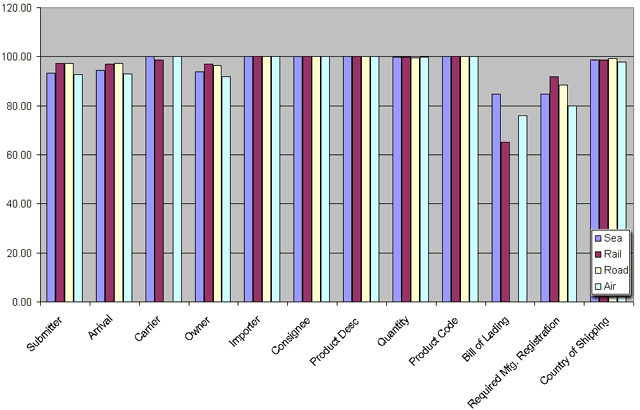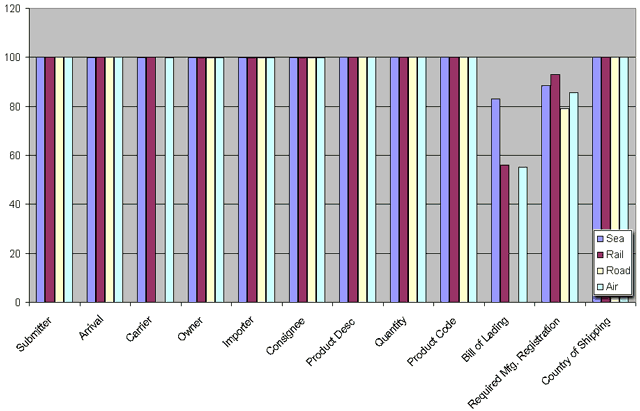|
The Public Health Security and Bioterrorism Preparedness and Response Act of 2002 (Bioterrorism Act), section 307, added section 801(m) to the Federal Food, Drug, and Cosmetic Act to require that FDA receive prior notice for food imported or offered for import into the United States. In the preamble to the interim final rule published October 10, 2003, FDA stated that it would provide a transition period, during which it would emphasize education on prior notice requirements to help industry better comply with the regulation.
A Compliance Policy Guide was issued in December 2003 to provide guidance on the agency's strategy for enforcing and achieving compliance with the interim final rule. In accordance with this strategy, FDA is providing summary information about the level of compliance with the prior notice requirements, including data on the types of errors in submitted prior notices. This information will also be analyzed to help FDA take appropriate enforcement action when necessary.
Information of interest to industry and other members of the public falls into two categories:
Information of both types is included in the accompanying charts. This is the third posting of summary information describing prior notice submissions. It includes some summary information from December through April and some snapshots of activity in July. FDA expects to continue to update information about prior notice even as the transition period ends.
Prior Notice Submissions by Source

As shown in the accompanying graph, FDA has been receiving about 160,000 prior notice submissions a week since February. About 86% (4.0 of 4.6 million) were submitted as additional information on transactions that already required submittal to the United States Customs and Border Protection (CBP) through its Automated Commercial System (ACS). FDA's existing interface with ACS was extensively modified to accept the prior notice transactions. About 13% of prior notices were submitted through FDA's new Web-based Prior Notice System Interface (PNSI). About half of those could have been submitted through ACS; the remainder were submitted for imports that are not required to file electronic entry with CBP. About 1% of the submissions came through the new interface (referred to as the"mini" ABI) that CBP and FDA provided for submitting information through ACS on food shipments that do not require CBP ACS submission at the time of arrival in the U.S., e.g. Transportation and Exportation, Immediate Transportation, and Foreign Trade Zones.
It is interesting to note that the percentage of submissions through PNSI and the "mini" ABI interface are steadily growing, and that PNSI already transmits a greater percentage of the total than FDA had expected. Note also that the number of submissions has remained relatively static through the summer months when imports of fresh fruits and vegetables are traditionally lower. This number can be expected to increase later in the year. Based on the current submission rate, FDA estimates that prior notice for over 8 million food products will have been submitted in the first year.
Virtually all of the submissions through ACS are initially Consumption entries, i.e., foods that are intended for consumption in the US and that are required to report to CBP. As the pie chart below shows, PNSI processes a wider variety of entry types.
PNSI Submissions by Entry Type

The graph below shows not only the steady growth of submissions through PNSI, but also the change in distribution. For simplification, it groups PNSI submissions into three major categories: consumption, in-bonds, and mail and baggage. For purposes of this graph, the term "consumption entries" includes entries classified by CBP as Consumption, Informal, Warehouse, and Temporary Importation under Bond. The term, "in-bonds" includes Transportation and Exportation and Immediate Transportation. As the graph indicates, most of the PNSI entries fall into the classification of consumption entries, as is true for those received through ACS.
PNSI Submissions by Type

Information about compliance has been of particular interest to both FDA and CBP, not only to identify filers/importers who are not in compliance, but to identify areas where large segments of industry are having trouble complying. The following graph shows the percentage of ACS submissions that are complete. Since increased enforcement began in June, entries submitted to CBP with no prior notice have been almost eliminated. Although some problems still exist, only a small percentage (about 0.5%) fail to submit any prior notice information.
Percentage of ACS Submissions Complete

The type of entry has a major impact on the specific information required. The following graphs indicate the compliance with required prior notice information for each of the major modes of transportation.
Percent Complete by Mode of Transportation (ACS) - July 2004

Percent Complete by Mode of Transportation (PNSI) - July 2004

Most prior notice data is being submitted. Importer, Consignee, Product Description, Quantity, Product Code and County of Shipping are all at or near 100% completion as is Carrier information for air, sea, and rail. Submitter, Arrival, and Owner are over 90%.
Carrier information for road transportation is difficult to address at a summary level. Because some informal shipments may be delivered via trucks which do not have a SCAC, the prior notice regulations require SCAC only when applicable; if none is available, the name and country of the carrier are required. In addition, since CBP requires SCAC and Bill of Lading only for air, sea, and rail, a submission without that information is not considered "incomplete" in this phase of the transitional period. Because summary data on SCAC and Bill of Lading for road transportation could be misleading in regard to overall compliance, they are not included in the summary graphs above. They are, however, actively being reviewed at a detailed level. And the submission of Carrier Code/Name, Bill Of Lading/Airway Bill Numbers for non-road modes is of significant concern as poor compliance could result in entry data rejections.
Completion of registration number and bill of lading is lower. Failure to submit a registration number for products that require one is a continuing concern. Facilities that manufacture/process, pack, or hold food intended for consumption in the U.S. are required to register. With certain exceptions, if an article of food is no longer in its natural state, the identity (name and address) of the manufacturer and the registration number assigned to the facility that is associated with the article of food is required in the prior notice.
Of the prior notices submitted through ACS, 13% contain no registration information and 3% contain a registration number that is not on file at the FDA. (Products not requiring registration numbers, e.g., grown/harvested products and PN submissions that have claimed an exemption from registration, are not included in the figures for "no registration.")

Another area currently under review is the timeliness of submissions. In the last week of June almost 7% of submissions through ACS (8965) were untimely as defined by the regulation. Although this had decreased from nearly 8% at the beginning of the month, the decrease was too small to be confident of a positive trend. As with other types of violations, shipments with untimely prior notice submissions could be held at the border.
FDA is also looking more closely at the validity and consistency of the data that is being entered. For example, although a consignee is entered on 100% of the submissions through ACS, our examination of the information entered indicates that almost 2% of consignee data indicates unknown/consolidated consignee, and not the ultimate consignee as required by the PN interim final rule. While 2% may seem small, the actual number found to be invalid for the week ending July 3 was 2466. This percentage is also diminishing, but as the transition period ends, submitters need to improve the quality of their submissions.
FDA and CBP are now actively identifying specific submitters and transmitters
(broker/filers) whose submissions tend to be error prone and are providing
information to
industry
to encourage
better compliance. We are also using the results of our compliance information
to review some of the most problematic compliance areas to determine how
to best improve compliance rates.